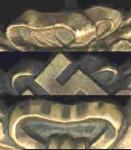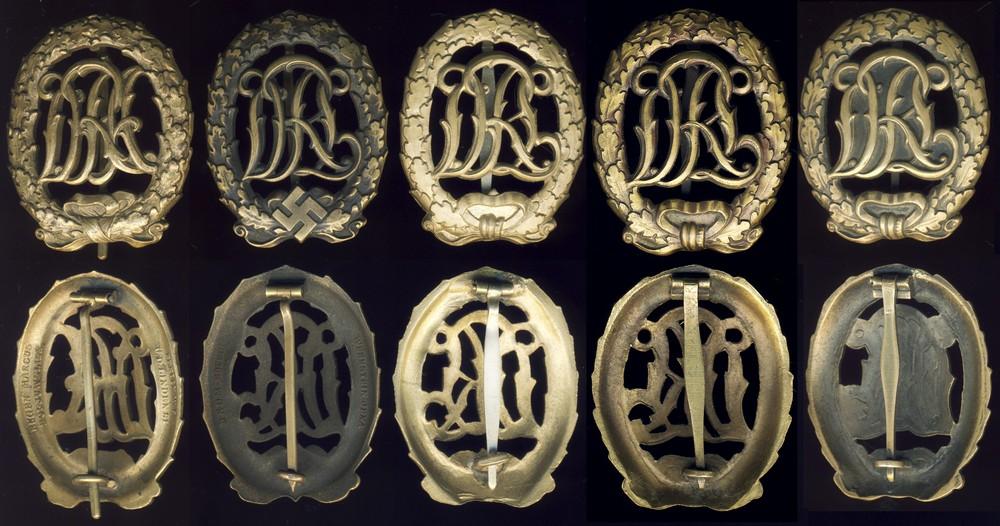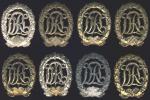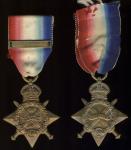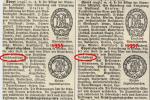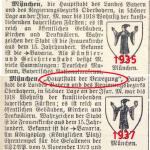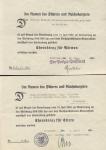-
Posts
1,628 -
Joined
-
Last visited
-
Days Won
2
Content Type
Profiles
Forums
Blogs
Gallery
Events
Store
Everything posted by speedytop
-

Bundesrepublik BRD Luftwaffe "Ike" tunic
speedytop replied to Ed_Haynes's topic in Germany: Post 1945: Bundesrepublik & DDR
Hi, it is a jacket belonging to the "Dienst- und Ausgehanzug" of the Luftwaffe, the service dress. For enlisted men and corporals/staff sergeants (Flieger - Stabsunteroffizier/Airmen - Staff Sergeant). It is the first type of a service dress in the Bundeswehr. The jacket is from 1956, "updated" 1957 with the collar tabs. The shoulder boards should be peaked and not rounded? The rank is Obergefreiter (UA). Airman 2nd Class, NCO candidate (UA = Unteroffizieranw?rter) Regards Uwe -
Here is the order, the time line which I prefer: A close view for the loops 1, 2 and 5: First number 1, than number 5 and than number 2? Do you really believe, that the sports organization, the "Deutscher Reichsbund f?r Leibes?bungen", say at the end of 1934/early in 1935 to the producer of the documents, print the documents with the badge with swastika, they told the producer of the cloth badges, that they have to produce the new form, DRL with swastika, and to the producer of the badges they say, make hundreds/thousends of badges without the swastika, cut out version or not cut out version, because we don't know, which design we choose? That is not the way of German organization. And the maker wait appr. 14 years or more, to sell these badges ? And do you really believe, that the "Deutscher Reichsbund f?r Leibes?bungen" had no information about such new in that period produced DRL bagdes without the swastika? Please notice, that I have searched in all the period folders in the Carl-Diem-Archiv in Cologne, in many hundred documents in the era 1933, 1934, 1935 and later. That is the largest and best archive about German sports badges you can find, all the documents from 1912 to this day. Not one document with a note for a DRL without the swastika! Regards Uwe I beg your pardon for my bad English, I could express it better in German
-
Hi Richard, "It is almost as if a large run of prototypes was made and not accepted." Why so many prototypes? Germans don't do that! Why should they do it, it is very expensive. No, absolutely not prototypes. That say my own experience. "Of those that are post 1945, most do have a MM ..." That is not correct. I have never seen an original large sports badge w/o the swastika (but with the tip) with a makers mark. The badges with MM are re-worked DRL with swastika. Only on miniatures I found post WW II maker marks, on a badge with and on a badge without the tip. "I don't know why they would have received a pin before being cut out as the cut out process surely must take place before the addition of the needle." There is a great number of these badges with the letters not cut out. So many wrong made pieces? That is not normal for Germans. "If the DRL without swas dies were a post war design, there would have been no need to rework the old DRL w/swaz dies." ????? Is it my insufficient knowledge of the English language? Please realize, we are in the post war area 1947, 1948, 1949. At that time they made dishes from steel helmets. Enclosed is first a picture with the order you prefer: Look at the loops, and look at the needles. Does that make sense?
-
Hi student, very interesting! Please see Post 42 - 44, and: http://gmic.co.uk/index.php?showtopic=20883&hl= The materiel from the swastika is complete removed and the rest is very good formed! I assume, that the badge is very thin at the marked postion, if you compare it with an DRL with swastika? Regards Uwe
-
Hi Richard V, "Based on these observations I had always assumed that the DRL without the swaz was quickly instituted to replace the DRL." When and for whom? Do you mean, to replace the DRA? "... a large number do not have the letters cut out and are essentially unfinished." The badges were complete finished, with a complete needle. "Some were finished out, most were not due to the fact that the powers that be decided to add a swastika to the design." To add to which design? Please explain me the time line of the DRL without the swastika, but with the "tip" ^. "There is no post war evidence of wear of the DRL without the swaz just as there are no pre war photos either." I cannot show period pictures of a DRL without swastika in the time frame 1934 - 1945, but I can e.g. present you pictures in post WW II catalogues of these sports badges without the swastika. Regards Uwe
-

DDR This is DDR medal?
speedytop replied to usairforce's topic in Germany: Post 1945: Bundesrepublik & DDR
-

14-15 star
speedytop replied to Colin O.'s topic in Great Britain: Orders, Gallantry, Campaign Medals
Hi, Edward C. Joslin, The Observer's Book of British Awards and Medals, London 1974: "... The first, approved in 1917, was the 1914 Star for award to those, who served in France and Belgium on the strength of a unit between 5 August and midnight on 22/23 November 1914; fewer than 400,000 were awarded. However, in October 1919, King George V sanctioned the award of a bar to the 1914 Star to all who had been under fire in France and Belgium between the above-mentioned dates. The bars, sewn onto the riband of the medal carried '5 AUG.-22.NOV. 1914'; the bar was represented on the tunic by a silver rosette. The majority of the recipients would have been the pre-war regular Army or the 'Old Contemptibles', a term derived from the Kaiser's reference to the British Army as the 'contemptible little army'. The third type is known as the 1914-15 Star which is identical to the 1914 Star except that the central scroll bar bears the date '1914-15' instead of '5 AUG.-22.NOV. 1914'. This 1914-15 Star was awarded to those who saw service in any theatre of war between the 5 August and 31. December 1915, except those who qualified for the 1914 Star; all were issued in bronze. ..." 1914 Star: 15109 PTE R. SHAW. I / G. GDS. 1914-15 Star: 13011 SGT J. LETCHFORD. R.F.A. Regards Uwe -
Hi Chris, it is complete decoded by rast. That is: "dess." with it is meant "desselben", that is (complete) in English: bataillon commander in the same regiment (such as my regimental commander wrote before) "The entry in the roll immediately above Corsep is for Oberstleutnant Hofmann, the commander of LIR 71." Regards Uwe
-

Unknown Award "f?r gute Leistung"
speedytop replied to FRanky's topic in Germany: Weimar Republic & Deutsche Freikorps
Hi, I think, it is not Berlin, it is in Switzerland, Bern (or Z?rich). And I.A.V. is for: Internationaler Artisten- und Musiker-Verband "Sicher wie Jold" See here, on page 30 you can see such a decoration, with crown and skull : http://www.sicherwiejold.ch/willkommen/ind...8&Itemid=30 Explanation: I.A.V. = Internationaler Artisten- und Musiker-Verband S.W.J. = Sicher wie Jold F?r gute Leistungen = for excellence II. Kl. = 2nd class And please see here: http://gmic.co.uk/index.php?showtopic=17981&hl= Regards Uwe -
Hi, it is written: Bataillons-Kom(mandeur) des 1. Rgts I can find Corsep 1890 Leutnant in the "3. Th?ringisches Infanterie-Regiment Nr. 71" (Schwarzburg-Sondershausen) 1901 Hauptmann in the "3. Th?ringisches Infanterie-Regiment Nr. 71" 1907 Hauptmann in the "3. Th?ringisches Infanterie-Regiment Nr. 71" 1910 Major in the "3. Th?ringisches Infanterie-Regiment Nr. 71", in the regimental staff. not 1913 1914 (WW I reactivated) Oberstleutnant in the "5. Lothringisches Infanterie-Regiment Nr. 144", at the end of the war in the "LIR 387" (Landwehr-Infanterie-Regiment Nr. 387) None of these numbers fits. Regards Uwe
-
And now let us have a look on the picture and the description for the sports badge (Sportabzeichen): Here in 1935 it is still the antiquated name "Deutscher Reichsausschuss f?r Leibes?bungen", but the new design, DRL with swastika. Antiquated, because the name of the organization already changed in 1934 to "Deutscher Reichsbund f?r Leibes?bungen (DRL)", see the lexikon from 1937. And now the unbeliever(s) must explain it : It is definitely before 1936 (Time frame 1934 thru 1937). I think, that everybody can accept now, that it is not only before 1937, it is definitely in 1935. There is no time frame for a DRL without the swastika. Regards Uwe I beg your pardon for my bad English.
-
Hi, it is about time, to post some more information Darrell: "Here is my collection of Bronze, Silver and Gold DRL badges without Swastika. Time frame 1934 thru 1937." "Until someone shows me "hard" evidence that they are post '45 I'm a believer." And now for the last(?) unbeliever: Some new (old) books I found very interesting, a lexikon from 1935 and one from 1937, "Der Volks-Brockhaus" Both are the 4th edition, but one with the year 1935 and the other with the year 1937: And I think, that the lexikon with 1935 is really from 1935, with the introduction of Mr. Brockhaus from "Herbst 1935" (fall/autumn 1935). From 1935 to 1937 only some changes, mostly for persons, some other interesting modifications for the Nazis. 1st: Munic (M?nchen) In August 1935 Hitler nominated Munic to the "Capital of the Movement" (Hauptstadt der Bewegung). In the lexikon from 1935 Munic is the "normal" capital of Bavaria, later it is the "Hauptstadt der Bewegung". And it was so important for the Nazis, that they added this title very quick, especial in Munic:
-

Bulgaria - Soldiers' Cross for Bravery
speedytop replied to Riley1965's topic in Southern European & Balkan States
-

Bulgaria - Soldiers' Cross for Bravery
speedytop replied to Riley1965's topic in Southern European & Balkan States
-

Bulgaria - Soldiers' Cross for Bravery
speedytop replied to Riley1965's topic in Southern European & Balkan States
-
Hi militaria0815, "Oh, was awarded in 3 different sizes, interesting indeed!" Nice comment, but i cannot understand it! Is award in your (my) language the same as available? "(Available in 3 sizes)" In our shared language (German) available stands for "vorliegend, vorhanden, verf?gbar" etc., but never for "verliehen" = awarded. Herzliche Gr?sse and Kind Regards Uwe
-
Hi, the complete name for the 3rd version is: Ehrenkreuz f?r die Witwen und Eltern gefallener, an den Folgen von Verwundung oder in Gefangenschaft verstorbener oder verschollener Kriegsteilnehmer. On the documents you can only find: Ehrenkreuz f?r Frontk?mpfer Ehrenkreuz f?r Kriegsteilnehmer Ehrenkreuz f?r Witwen Ehrenkreuz f?r Eltern Regards Uwe



